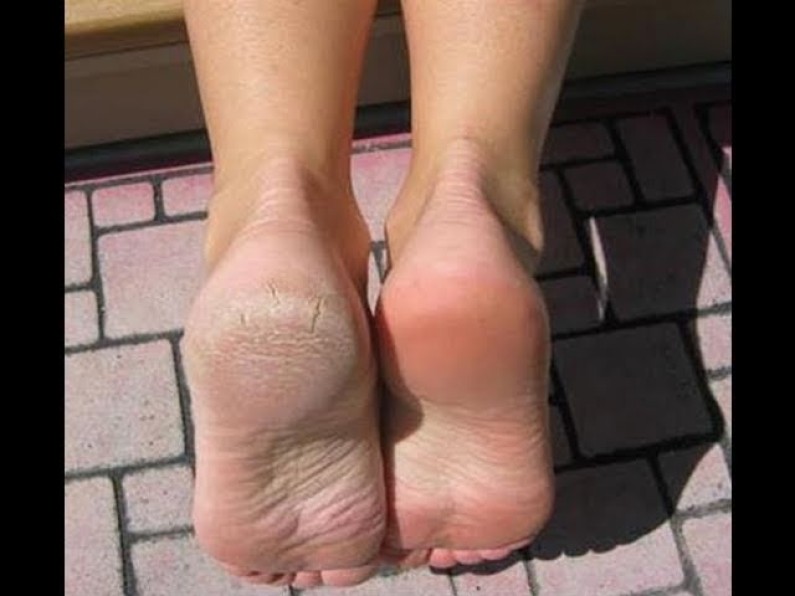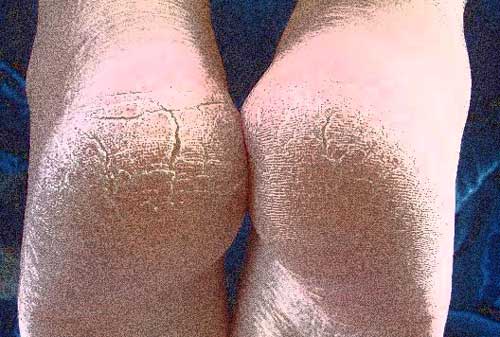

Dermatologists and podiatrists are frequently sought out to cure hyperhydrosis – or dry skin problems, especially of the bottom of the feet which can lead to cracking, fissured skin, not to mention stockings which can be torn from the snags. Dry skin is an oxymoron – dryness of the external layer is the normal state of all skin. The outer layer consists of a protein which forms the fibrous horny layer called keratin. Importantly, to prevent the sub-dermal layers from drying out, keratin is optimized while in a completely hydrated state which increases the length of their fibers. Notably, total hydration of the keratin fibers occurs at about 16 percent water. Below that threshold, keratin fibers become more permeable to substances moving through the skin layer, into the body.
Two mechanisms increase dryness of the plantar skin on the bottom of the non-diseased foot. Firstly, any pressure directed by ground-reactive forces onto the bottom of the foot can cause a hyperkeratotic reaction – especially if the force is pinpoint or from constant friction, causing the skin to thicken in response. This phenomenon is common in women using flip-flops, slide-type shoes and certain shoes without heel straps, all which allow the heel to be exposed, with the rim of the shoe projecting upward into the plantar skin. The unrestrained heel moves about upon the platform of the shoe-edge which is propelled upward by ground-reactive forces to dig into the skin with each step. Such a consistent pressure, aided by the mechanical shear from friction causes a hypertrophic reaction resulting in thickened skin at the rim of the heel which can result in discomfort, pain and can lead to cracked, fissured skin.
The second mechanism is self-induced. When skin is moistened as happens during a shower or bath, it becomes water-logged. Too much hydration causes the keratin fibers to shorten, exposing more of the sub dermal layers and allowing the skin to become more permeable. During conditions of hyper hydration as with a bath or shower the increased permeability of the skin allows an enhanced loss of hydration as the skin goes through the drying process. While drying off after the bath, air passing over the skin further accelerates the drying of the skin as evidenced by the rush of cold we feel after leaving the tub.
The prevent this turbo-drying effect of the shortened keratin fibers and the rapid drying of the skin hastened by the use of a dry cloth, it is necessary to close the “keratin door” to limit the loss of water through the skin. The first and most important step is to discontinue drying the body after bathing! Instead, use an occluding agent to coat the skin with an impermeable layer. The magic of this solution is that it does not require the use of exotic, expensive or complicated materials as the curative agent is easily found in any kitchen or bathroom. Most inexpensive lotion, oil or ointment if used in the proper manner will reduce dry skin in a short period of time and prevent further occurrences. Crisco, avocado oil, coconut oil, petroleum jelly and even canola oil will do.
So to finally rid yourself of dry skin, fissures and cracks of the feet and to close the keratin door, simply stop drying the skin! Instead mix your favorite occluding agent in with the water drops all over your body and rub it in to cover all surfaces. This process traps the water already present in the skin and prevents it from being infused into the air at the skin surface. The water molecules then saturate down into the dermal layers where they belong and the balance of hydration is soon restored giving you soft, supple skin again.
By LC Loggins
Sources:
ANATOMY OF THE SKIN: Electronic Textbook of Dermatology, Anatomy of the Skin, Maged N. Kamel, M.D.
DermNet NZ: Emollients and moisturizers
Hyperkeratosis: Drugs.com


